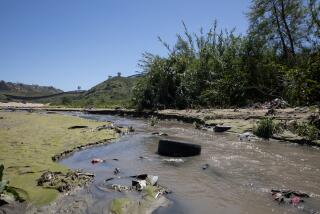City OKs Plan to Treat Border Sewage
Prompted by growing concerns for public health, the San Diego City Council and county, state and federal authorities agreed Tuesday to seek funding for an immediate solution to the festering sewage problem in the Tijuana River Valley.
The plan calls for raw Mexican sewage to be piped from the river valley to the cityâs Point Loma Wastewater Treatment Plant beginning in about six weeks.
Initial cost of the project is expected to be about $500,000, with annual operating expenses running more than $3.5 million.
It was unclear exactly how the financing would be distributed among the participating agencies: the U.S. and Mexican governments, the state of California, San Diego County and the city of San Diego.
The state and federal governments are expected to shoulder nearly all expenses, but if there is a shortfall of that funding, San Diegans could be hit with another rate increase, said Roger Frauenfelder, deputy city manager. Local residents already face higher sewage bills to pay for a planned $2.8-billion upgrade of the Point Loma plant and the cityâs overall sewage system.
More than three dozen South Bay residents packed council chambers Tuesday, heckling, shouting, urging council members to approve the plan and finally breaking into thunderous applause when the unanimous vote came through.
Residents complained bitterly and area public health officials warned that the raw sewage is not only an aesthetic nuisance but is attracting an increasing number of mosquitoes that can transmit malaria and encephalitis.
The project is an interim solution until the mid-1990s when the United States and Mexico are expected to complete construction of a joint treatment plant to handle the Tijuana River Valley sewage problem.
Under the proposal:
* A pumping station will be installed near the international border and a pipeline will carry up to 14-million gallons of raw Mexican sewage to the Point Loma plant daily.
* No fines or penalties would be imposed against San Diego by state and federal regulatory agencies for discharge permit violations or sewage flows exceeding capacity limits.
* The Mexican sewage would be stopped if the treatment plant reaches capacity.
* The U.S. government will be responsible for collecting and disposing of leftover sludge.
* The city of San Diego will not be liable under any lawsuits resulting from the project.
At the council meeting, Mayor Maureen OâConnor took the most heckling, mostly from a woman who was angered by the mayorâs apparent reluctance to support the project without specific financial commitments from the county, state and federal governments.
âHey, lady, you try living down there with all that stinking mess and see how you like it!â the woman screamed at the mayor in one outburst.
Defending her record on environmental issues, OâConnor repeatedly banged her gavel in an effort to control the constant interruptions from the audience, which quieted periodically until inflamed again.
Untreated Mexican sewage has been flowing across the border for decades, but Tijuanaâs growing inability to handle its waste water has become a crisis. Once a periodic problem, it has escalated into a potential health threat of massive proportions, city officials said.
Since 1987 the amount of raw sewage in the Tijuana River Valley has increased from 6 million gallons per day to as much as 12 million gallons, city officials said.
San Diego has treated Mexican sewage on an emergency basis in the past. But that system, which is capable of handling about 13 million gallons of sewage daily, has been shut down because of diminished capacity, officials said.
City officials have expressed concern that the influx of new sewage into the Point Loma plant will push the facility to capacity, which could prompt regulatory agencies to threaten building moratoriums.
More to Read
Sign up for Essential California
The most important California stories and recommendations in your inbox every morning.
You may occasionally receive promotional content from the Los Angeles Times.










